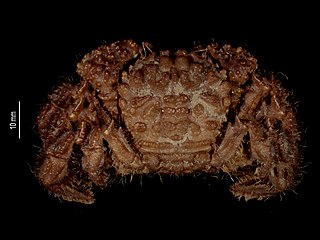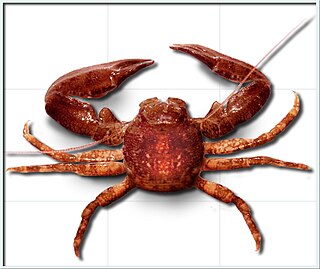
Crabs are decapod crustaceans of the infraorder Brachyura, which typically have a very short projecting "tail" (abdomen), usually hidden entirely under the thorax. They live in all the world's oceans, in freshwater, and on land, are generally covered with a thick exoskeleton, and have a single pair of pincers on each arm. They first appeared during the Jurassic Period.

The Japanese spider crab is a species of marine crab and is the biggest one that lives in the waters around Japan. It has the largest known leg-span of any arthropod. The Japanese name for this species is taka-ashi-gani,, literally translating to “tall legs crab”. It goes through three main larval stages along with a prezoeal stage to grow to its great size.

Raninidae is a family of unusual crabs, sometimes known as "frog crabs", on account of their frog-like appearance. They are taken by most scientists to be quite primitive among the true crabs. They closely resemble the (unrelated) mole crabs, due to parallel evolution or convergent evolution. In both groups, the claws are modified into tools for digging, and the body is a rounded shape that is easy to bury in sand. Unlike most other true crabs, the abdomens of raninids are not curled under the cephalothorax.

Notomithrax ursus, known as the hairy seaweed crab, is a spider crab of the family Majidae.

Johngarthia is a genus of crabs in the land crab family Gecarcinidae, formerly included in the genus Gecarcinus, and containing six species. The genus bears the name of John S. Garth, a 20th century naturalist who specialized in crabs and other arthropods.

Latreilliidae is a small family of crabs. They are relatively small, long-legged crabs found on soft bottoms at depths of up 700 metres (2,300 ft) in mostly tropical and subtemperate waters around the world. Their carapace is very small and doesn’t cover the bases of their legs, which protrude from the cephalothorax in a spider-like manner. The family and its type genus are named after Pierre André Latreille. The oldest known fossils from the Latreillidae have been dated to the middle of the Cretaceous period. It comprises seven extant species.

Vultocinus anfractus is a species of crab, the only species in the family Vultocinidae. It has been found around the Philippines, Vanuatu and New Caledonia, and lives on driftwood. Its discovery forced a reappraisal of the relationships within the superfamily Goneplacoidea, and to the recognition of Mathildellidae, Conleyidae and Progeryonidae as separate families.

Xantho poressa, the jaguar round crab, is a species of crab from the eastern Atlantic Ocean. It is one of four species in the genus Xantho.

Pisidia longicornis, the long-clawed porcelain crab, is a species of porcelain crab that lives in the north-eastern Atlantic Ocean. It varies from reddish to white, and grows to a carapace width of 1 cm (0.4 in). It was first named by Carl Linnaeus in 1767, although the etymology remains unclear.

Guinotellus melvillensis is a species of crabs in the family Xanthidae, the only species in the genus Guinotellus. It is a benthic crab with an ovate carapace within the subfamily Euxanthinae.
Libinia ferreirae is a species of tropical spider crab in the family Epialtidae. It is found on the seabed in shallow waters off the Atlantic coast of South America.

Pyromaia tuberculata is a species of crab in the family Inachoididae.
Emerita rathbunae is a species of "mole crabs" or "sand crabs" in the genus Emerita that lives along the tropical Pacific coasts of the Americas.

Dyspanopeus texanus is a species of crab known as the Texas mud crab.

Hyastenus hilgendorfi is a species of spider crab from the family Epialtidae, classified in the sub-family Pisinae, from the Indo-Pacific region. It has been recorded in the Suez Canal and there have been a few records in the eastern Mediterranean, making it a Lessepsian migrant.

Armases cinereum, also known as the squareback marsh crab or wharf crab, is a species of crab in the family Sesarmidae. The wharf crab is a small crab that is dark brown to muddy in color, which allows it to blend in with its usual surroundings. It is found on the Atlantic southeastern coast, down into the Gulf of Mexico. It is an omnivore and is prevalent in marshy coastal environments along the Southwestern Atlantic.

Libinia spinosa is a majoid crab found in mud and sand bottoms of the Southwestern Atlantic and Pacific oceans. It is a generalist feeder on organisms such as algae, sponges, cnidarians, mollusks, polychaetes, crustaceans, and small fish. It commonly engages in a symbiotic relationship with the medusa Lychnorhiza lucerna.
Parveen F. Absar is a wildlife biologist from India. In 2017, she was credited with the discovery of a species of freshwater crab called Teretamon absarum, of the genus Teretamon and species speleaum.

Petrolisthes violaceus is a species of porcelain crab endemic to the south-eastern Pacific.
















